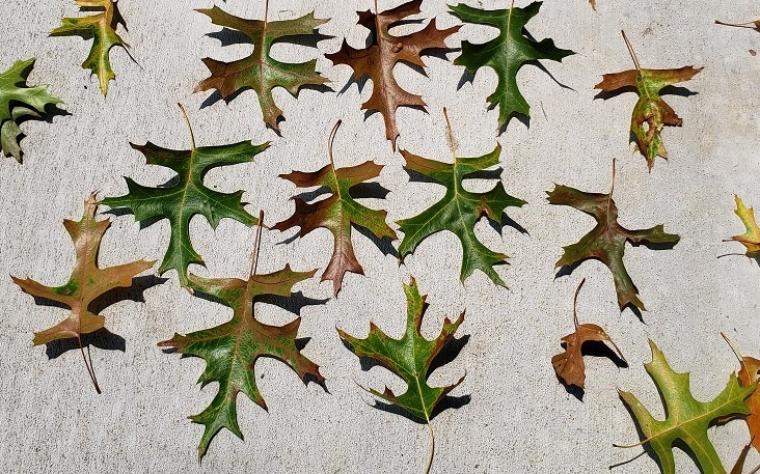COLUMBIA, Mo. – University of Missouri Extension’s Plant Diagnostic Clinic, in partnership with the Missouri Department of Conservation, continues to offer free testing for all common oak tree diseases in 2025.
“We had a great season in 2024 as we received a total of 93 oak samples and diagnosed diseases including oak wilt, bacterial leaf scorch, tubakia leaf spot, anthracnose, cicada damage and so on,” says Peng Tian, director of the Plant Diagnostic Clinic on the MU campus.
“This allowed us to monitor the prevalence of the common diseases currently in Missouri and scout for new or invasive diseases of oaks to better assist MDC and the Missouri Department of Agriculture with controlling forest pest problems,” Tian says. “With this service, we hope to continue collecting information on the location and host species of oak diseases across the state and monitor the tree health of the state.”
Oaks are the most abundant trees in yard and forest settings across Missouri. Two common oak diseases are bacterial leaf scorch and oak wilt. Oak wilt weakens white oaks and kills red oak trees within weeks of infection. Bacterial leaf scorch is a chronic disease that worsens over several years. Both diseases spread to nearby oaks.
Oak wilt symptoms first appear in late spring or early summer in red oak. Leaves discolor, wilt and fall, first at the top of the tree and later at the tips of lateral branches. Leaves turn a dull, bronzed brown at the tips and along the outer margins. Similar symptoms appear in white oak trees in mid-to-late summer. Trees infected for two or more years commonly develop isolated dead branches in the crown.
Bacterial leaf scorch infects the xylem of susceptible trees and prevents transport of water and nutrients. There is no cure for bacterial leaf scorch on oak, and trees die in 5-8 years. Symptoms are like those of drought stress and can only be diagnosed by laboratory analysis.
If you suspect either disease in your trees, Tian recommends sending a sample for testing and confirmation to the diagnostic clinic.
First, send 3-5 photos of the tree to the clinic through digital sample submission. Tian suggests submitting both close-up photos and photos from a distance.
The fee noted on the website will be waived for tests for common oak diseases.
“MU Plant Diagnostic Clinic staff will contact you regarding the physical sample submission guidelines depending on the tree health problems observed in the photos,” he says.
For bacterial leaf scorch testing on oaks, select leaves that are still green but show leaf scorch symptoms. Collect 20-30 leaves with the petiole (leaf stem) attached and pack them in a sealed plastic storage bag with a damp paper towel. Keep the leaves cool.
For oak wilt testing, collect 20-30 leaves and 4-6 branch sections that are about 8-12 inches long, roughly 0.5-1.5 inch in diameter, and are alive but showing symptoms of leaf wilt.
Keep samples cool, but do not freeze them, says Tian. Infected samples that get hot during transit to the lab may not test positive for the fungus.
For both tests, he recommends contacting the lab about shipping recommendations and timing.
For more information on sample submission, go to the Plant Diagnostic Clinic website. The clinic is at 1100 University Ave., 28 Mumford Hall, Columbia, and is open 9 a.m. to 4 p.m. Monday to Friday.
Video
Photos
Oak tree
Signs of disease can be seen in this oak tree immediately to the right of the brick house. MU Extension’s Plant Diagnostic Clinic, in partnership with the Missouri Department of Conservation, offers free testing for all common oak tree diseases in 2025. Photo by Clinton Meinhardt, MU Life Sciences Center.
Oak leaves
With oak wilt, leaves discolor, wilt and fall at the top of the tree first and later at the tips of lateral branches. Leaves turn a dull, bronzed brown at the tips and along the outer margins. MU Extension and MDC have partnered to offer free testing for all common oak tree diseases in 2025. Photo by Clinton Meinhardt, MU Life Sciences Center.

